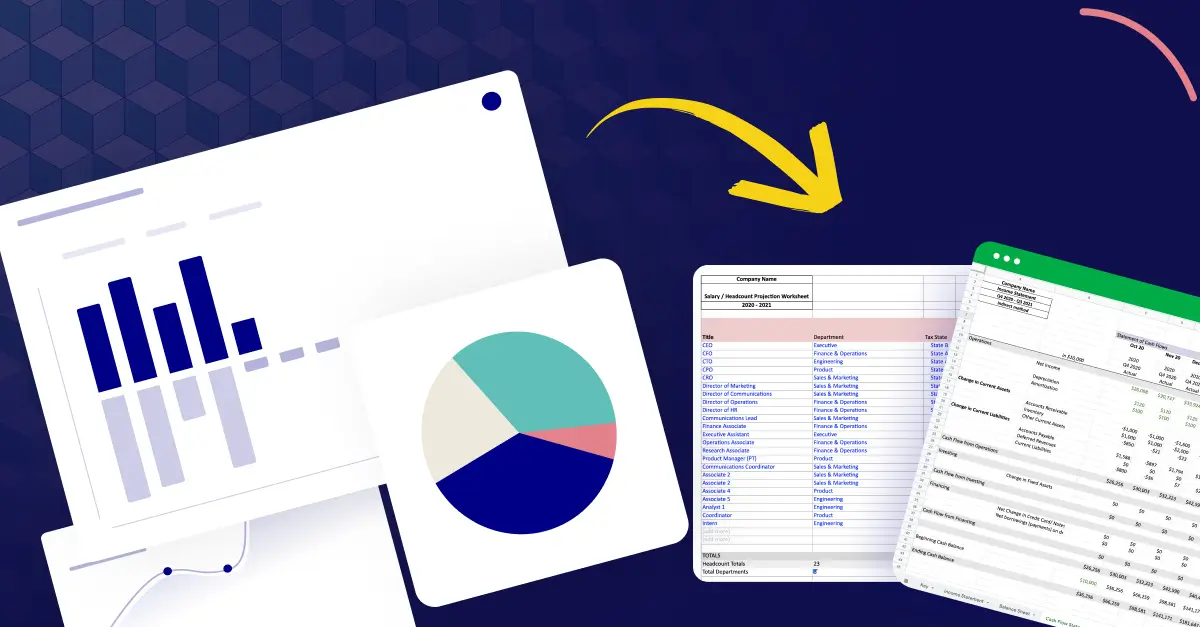What are organizational plans?
Organizational planning is strategizing and preparing for a business's future successes.
One of the big organizational planning goals is to create strategic and tactical plans to guide the entire organization forward.
The plan can cover an organization's operations, marketing, financials, staffing, etc. Its purpose is to ensure departments collaborate to reach company goals.
Organizational planning allows businesses to anticipate market fluctuations and weather economic change without suffering losses.
A clear roadmap of where the company wants to go better helps to focus its efforts on reaching desired outcomes.

What are the benefits of organizational planning?
If your company wants to grow, you need a game plan. This is the essence of an organizational plan.
Establishing and supporting organizational planning has many benefits beyond simply delivering on your company’s ambitions.
These are some of the ways the organizational planning process creates benefits for forward-thinking companies:
Clear goals for the organization
Organizational planning helps define and set achievable targets for the organization and its teams.
It articulates the company's overall vision, provides a roadmap for how to get there, and creates measurable goals with time frames for achieving them. This built-in clarity gives teams clear and reasonable steps to align their efforts with the organization's larger objectives.
Organizational planning also creates feedback loops to ensure that teams are making progress toward achieving their targets on schedule. This makes it easier to identify areas needing improvement or resources.
Organizations can ensure they are efficiently working towards their desired outcomes by setting clear goals.
Visibility into gaps or opportunities
Organizational planning breaks down data siloes and creates action plans, allowing the organization to identify areas of improvement or potential growth.
With this visibility, organizations can create better strategies and more clarity into the actions that lead to success.
Better employee morale and productivity
Well-informed and properly motivated employees have higher satisfaction and better retention rates than those without a clear roadmap to success.
Organizational planning allows every team member to see their role in the successful execution of plans and helps them stay engaged in the organization’s mission.
More resilience and agility
Organizational planning helps companies make quick decisions knowing that their goals will remain achievable through challenges.
Different types of organizational planning, such as financial planning, strategy implementation, and risk management, guide teams facing uncertainty or disruption.
- Financial planning enables organizations to adjust their budgets according to changes in the market.
- Strategic implementation provides a practical roadmap for success.
- Risk management allows businesses to anticipate and mitigate risks before they become major problems.
By using these different types of organizational planning, companies can adapt quickly to changing conditions and be better prepared for any eventuality.
Better cost savings and optimization
When you know what to do, you’re less likely to spend time and money trying things that may not work.
An organizational plan gives your teams a roadmap for conducting business, resulting in less waste and better outcomes.
This also translates to better profit margins due to the increased spending efficiency of a well-crafted budget and plans.
Types of organizational planning
Organizational planning covers several different approaches aimed at different facets of the business.
Some organizational planning examples include strategic planning, driver-based planning, and tactical planning.
Each of the below types of planning plays a different role in helping the company, and its team members do what they set out to accomplish.
Strategic planning
Strategic planning is a type of organizational planning focused on setting goals, developing strategies and tactics, and providing resources to get the job done.
It involves analyzing the organization's current situation or creating a vision for the future while considering factors such as external conditions, competitive landscape, customer needs and expectations, resource availability, and other internal considerations.
Strategic plans are usually communicated in an organizational strategy document that outlines the key objectives and initiatives required to realize these objectives.
They create the larger framework and metrics for success. Teams then execute tactical plans to fulfill the requirements of the broader strategic approach.
Driver-based planning
Driver-based planning is a process of connecting financial plans to strategic and operational activities. It helps organizations to identify, prioritize and track the most critical actions to drive success.
Driver-based planning incorporates financial goals and operational performance into the plan, allowing for comparing financial data with projected performance. It uses business drivers—core activities that produce results for the business—to build financial models and connect them to operational activities.
Using driver-based planning, organizations remain agile, adapt their plans based on changing conditions, and stay focused on results.
Tactical planning
If strategic planning provides the broad strokes of achieving your organization’s objectives, tactical add minor details.
Tactical planning involves identifying specific tasks and activities that must be done within a given timeframe to ensure overall strategic success.
A tactical plan is created using information gathered during the strategic planning process and feedback from stakeholders, staff, and external advisors.
These plans are typically drawn up quarterly or yearly, including everything from budgeting to marketing strategies.
Operational planning
Operational plans are like user manuals for every area of your organization, from HR and hiring to financial planning and risk management. They help govern the day-to-day activities of your different business units.
Operational planning defines your organization’s goals and objectives and outlines the steps and procedures for achieving them.
It involves identifying specific tasks to be performed by each area of your business and setting out roles, responsibilities, timelines, and budgets. It's essential for successful organizational performance as it ensures that all processes are cohesive.
Operational plans provide the framework for managing day-to-day operations while positioning your organization to meet longer-term goals.
A well-crafted operational plan will help keep your team focused and on track to achieve success.
Contingency Planning
Life happens when you’re making other plans, which is also true of business life. Contingency planning aims to handle precisely those moments in your company’s journey.
Contingency planning is a type of organizational planning used to prepare organizations for uncertain and unpredictable events.
It’s an important part of any organization's success, as it provides the flexibility and resilience needed to withstand and recover in an ever-changing business environment.
Contingency planning focuses on preparing for potential risks and responding quickly when they occur, allowing the organization to make decisions confidently in the face of unexpected market changes.
The goal is to reduce disruption, mitigate losses, and ensure the continuity of operations.
Contingency plans typically include strategies for risk management, business continuity, disaster recovery, and crisis management.
Capacity Planning
Planning for future projects requires a keen view of the resources, people, and tools needed to achieve your goals. This is the goal of capacity planning.
It involves understanding the organization's current and future resources regarding personnel, infrastructure, technology, and other capabilities.
Capacity planning also considers a range of potential scenarios to determine the optimal resource levels needed to handle them. This helps the organization proactively manage resources and avoid potential risks or disruptions.
By increasing its capacity ahead of time, the organization is better prepared to respond quickly and effectively when faced with unexpected events.
Workforce planning
Workforce development is a part of capacity planning, focusing on personnel and organizational structure.
It involves carefully monitoring and analyzing the organization's current and future employment requirements and skill sets. This helps identify talent, skills, or experience gaps that could be addressed through strategic recruitment or training initiatives.
Workforce planning also allows organizations to anticipate potential labor shortages or surpluses and adjust hiring plans to ensure optimal workforce utilization.

A 5-steps organizational planning process
Every organizational plan addresses different needs but follows a repeatable pattern for success. Plan your next organizational strategy using the following steps:
1. Define your goals
Outlining your goals is essential to ensure you understand the challenge and have the resources and capabilities to solve it.
Allocate time for your team to discuss the most critical objectives and prioritize them accordingly.
Once your organization's main objectives are determined, you can start breaking down the tasks needed to achieve them into smaller, more manageable steps.
2. Analyze your current process
Understanding your current organizational practices helps you decide on actions for future improvement.
Depending on the size of your organization and the complexity of its processes, conducting a thorough examination may require additional research and data analysis.
3. Seek stakeholder input
Soliciting input creates different perspectives on your processes and plan.
Through stakeholder contributions, you include valuable perspectives and identify resources.
It also better prepares teams to support the organization and its goals.
4. Develop a plan
Decide the specific, measurable actions departments will take to reach established goals. This includes:
- Establishing deadlines
- Determining roles for key personnel
- Assigning tasks and activities
- Setting project management milestones
- Selecting and tracking key performance indicators (KPIs)
5. Measure results
Measuring and tracking KPIs lets you assess your progress and course correct where needed. KPIs provide a means of gauging the success or failure of specific actions. They can be used to inform and direct future strategies.
Organizations can make more informed decisions and stay ahead of challenges by establishing measurable goals and monitoring performance.
Conclusion
Conclusion: your strategic plan and organizational plans
Now you know all about organizational plans.
How to make them, how they're categorized, and why you should have them.
And we're big planners here at Cube.
If you're looking to level up your planning in Excel, you should request a demo with Cube.
Cube integrates with your source systems, Excel, and Google Sheets, so it's easy for anybody to get the information they need.
You can plan at a high level with vendor-level financials at your fingertips.
Sound intriguing? Click the image below to request a demo today.



.png)









![Best strategic planning software for CFOs [2025 review]](https://www.cubesoftware.com/hubfs/Strategic-Planning-Software%20%281%29.webp)